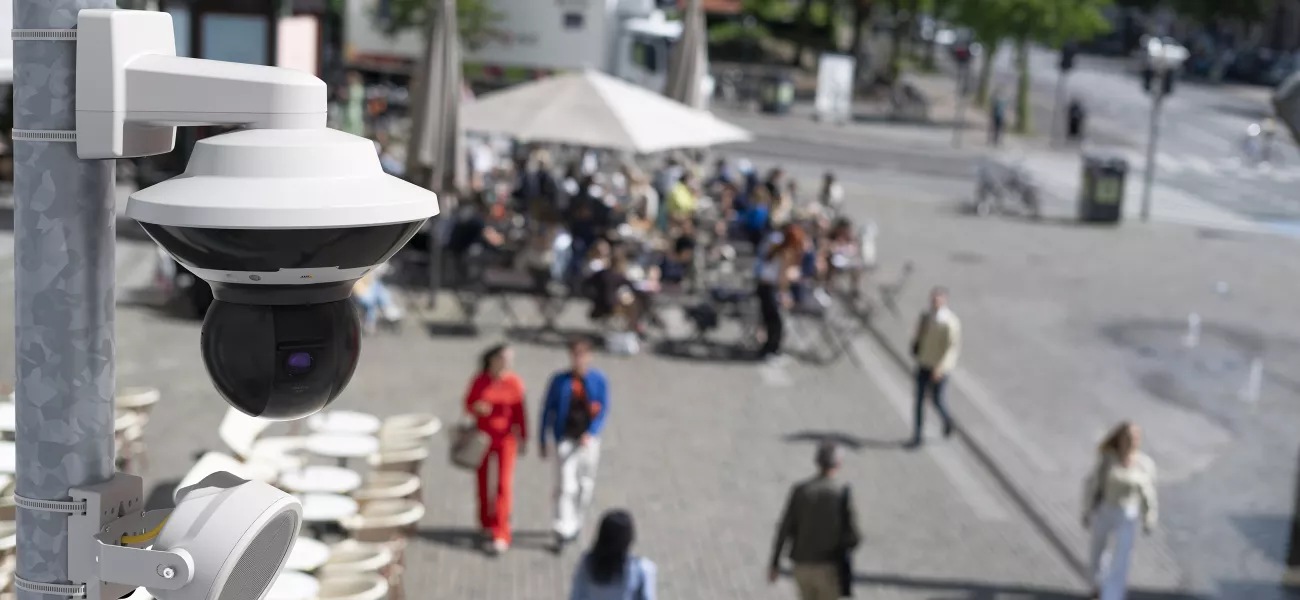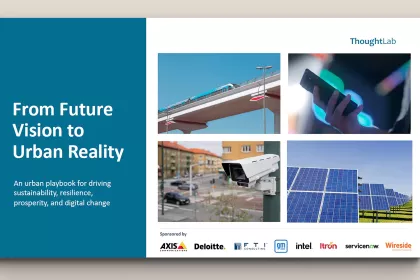
Axis Communications announces the launch of one of the most comprehensive studies of smart cities ever conducted. ThoughtLab’s report explores how city leaders are tackling today’s urban challenges and highlights the most effective strategies and digital solutions to prepare for the future.
To better understand how leading cities prioritize and steer their decision making, global research firm, ThoughtLab, surveyed 250 cities from across the world. The result, its pioneering From Future Vision to Urban Reality report. This material provides an actionable playbook detailing the strategies, technologies, and investment tactics city authorities can use to meet the shifting expectations and behaviors of their citizens, while also offering benchmarking insights to help them assess their progress.
The research was sponsored by Axis Communications, as well as Deloitte, FTI Consulting, Intel, Itron, ServiceNow, and Wireside Communications, among others. The size and scope of the report, representing 9% of the global population, made it one of the most comprehensive studies of smart cities ever conducted.
Being able to benchmark your city’s performance against peers is an immensely powerful tool for city leaders,
explains Anders Grafström, Global End Customer Marketing Manager, Axis Communications. “ThoughtLab’s report not only provides a detailed and thoughtful analysis of key performance indicators, but also the steps and considerations to improve them.”
Identifying future-ready cities
ThoughtLab used its research findings, along with additional third-party data, to produce a model to benchmark the ‘future-readiness’ of cities; that is, how well equipped they are to face the challenges of tomorrow across fields such as the environment and sustainability, safety and crime, mobility and transportation, and citizen health. A total of 50 cities were categorized as future-ready; 150 as progressing toward future-readiness; and 50 as beginners in an earlier stage of development. Some of the future-ready cities in each region are:
- North America: Boston, Chicago, San Francisco, Seattle, and Toronto
- Latin America: Buenos Aires, Caracas, Quito, Rosario, and Salvador
- Europe: Edinburgh, Helsinki, Lyon, Madrid, and Vienna
- Middle East & Africa: Ankara, Doha, Kampala, Rabat, and Tehran
- Asia Pacific: Beijing, Guangzhou, Melbourne, Taipei, and Tokyo
Ahead of the pack
Across the board, future-ready cities far outpace their peers with their preparedness. In almost all cases, many times over. When it comes to safety, security, and resilience, for example, 70% of future-ready cities report having made significant progress. This compares to just 17% of the other remaining 200, non-future-ready cities.
The same pattern repeats for environmental and sustainability preparedness (66% vs. 11%), living, health, and trust (62% vs. 21%), mobility and transportation (58% vs. 12%), and urban infrastructure (54% vs 11%). The result: Future-ready cities are far safer, more inclusive, resilient, sustainable, and digitally enabled. Citizens are healthier and experience a higher standard of living.
“While the gulf between future-ready cities and their peers is large, it highlights how, with relatively straightforward and targeted strategies, cities can quickly make meaningful and enduring improvements,” continues Grafström. “But achieving true future-readiness means thinking holistically, developing cross-functional roadmaps that build off firm, data-driven foundations. Working closely with partners and innovative minds that expand what is possible for your city. It comes down to giving yourselves the tools, information, and leverage you need to make the right decisions in the best possible way.”
Achieving future-readiness
In its assessment, ThoughtLab identified six themes consistently present within each future-ready city. The combination of these principles results in a powerful operating model for cities that inherently drives future-readiness. They are:
- Placing humans at the center of their strategies by creating an urban environment that enhances every aspect of city life, from infrastructure to mobility.
- Creating frictionless experiences for citizens by making urban living easy, efficient, and seamless, moving from siloed solutions to integrated digital systems.
- Taking a cross-departmental, holistic approach to problem-solving.
- Integrating innovation ecosystems into operating models by collaborating with technology startups and established tech firms.
- Diversifying funding and business models beyond traditional taxes and fees to fund investments.
- Building productive, skilled, and diverse workforces, by nurturing and attracting talent and removing barriers.
To achieve many of these principles, cities use a combination of IoT sensors, surveillance and security technologies. These provide valuable and actionable sources of data to inform decisions, justify investments, gauge successes, and enhance city workflows. Their use of AI, in combination with these data feeds and automation tools, allows them to boost productivity, drive efficiencies, and better meet the needs of their citizens.

